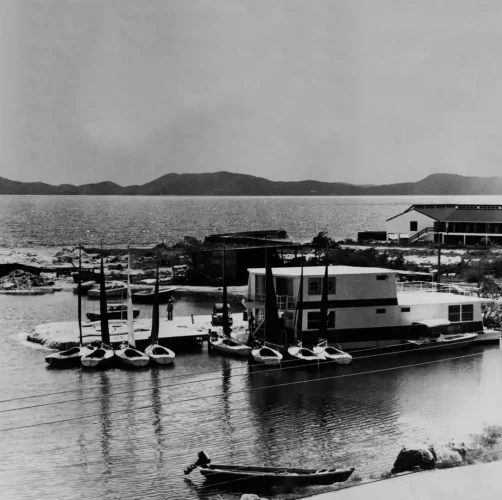If You Can't Tie a Knot, Tie a Lot – How many of us really know which knot to tie, how to tie it, and when to tie it?
A half-inch dinghy tow line has a breaking strain of 3780 lbs. Should a wayward overhand knot find its way into the tow line, that strength is now halved—to 1890 lbs. Have you ever snapped a dinghy line while towing? I have, and it sounded like a gunshot. I’m glad I wasn’t in the path of the whiplashing line, since nylon snaps at 700 feet per second when it breaks. Where did my line break? At the knot that had cleverly woven itself into my tow line. Maybe your anchor line has a knot in it somewhere. Do you feel comfortable sleeping overnight in a 25-knot wind with an anchor rode only half as strong as it is meant to be?

Anchored near The Willy T, one can pass a pleasant afternoon watching the antics of other boats trying to pick up a mooring line. After the third approach, the five people on the foredeck manage to grab the mooring ball pendant. Now, how to secure the boat so that they can all go to the Willy T, overindulge, and then return and find it just where they left it? Whatever they do, they should secure it so as to be able to leave at a moment’s notice. The too-common, bowline from starboard cleat, through the pendant, then bowline to the port cleat has many disadvantages. The single line can saw through the plastic hard eye of the mooring pendant. If it is a metal hard eye, the metal hard eye will saw through the line, or if it is a spliced soft eye, both lines will saw through each other. Your boat may well not be there on your return, but instead aground on The Indians! And remember, a bowline is impossible to undo under any strain.
Instead the mooring line should be bowlined through the cleat, or even just around it, led through the pendant, then back to the SAME cleat. Make a full circle around the cleat, then an X or two, and finish with a full circle again. Leave out the locking turn, as those are best for small sailing dinghies. Do this twice, once for starboard hull, once for port hull, or run two lines, to port and starboard cleats, for a monohull. The OXO, or OXXO, will not come undone, not even under full reverse, yet it can be released under any amount of strain. The bowline will keep the end attached to the boat. By the way, it is a good idea to make sure your mooring ball lines can’t reach your props in case they are dropped overboard while you motor race to the last ball at The Indians at 7:30 am. Take it from me, it happens!

Tying your dinghy to a horizontal piece of wood at The Bitter End Yacht Club, try a clove hitch. Did your reef line come undone from the boom, or fray at the clew? Try a running bowline, or a buntline hitch. Does your jib sheet need a stopper knot? Use a Figure Eight—but leave enough line after the knot to still reach the winch.
No one is saying that we need to memorize Ashley’s book of knots, or aspire to outdo Brian Toss as a master rigger. But the few knots we need to know, we should know well. It is what sets sailors apart from passengers.





